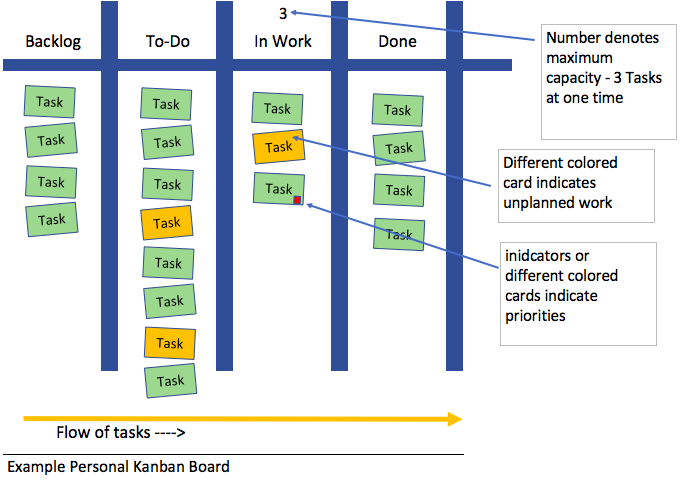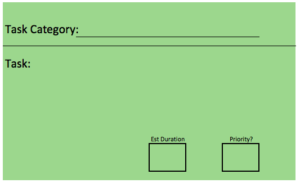In one of our recent posts 6 reasons why you suck at managing your workload we discussed some work productivity ideas. We talked about to-do lists as one of the most powerful tools you can use in workload management, while there’s a plethora of tools available out there, one of the options available that we really love is the Kanban Board.
While the Kanban board might be new to you, they are not new to industry and have been around for a long time. You often find Kanban boards at work in production or manufacturing boards used as a method of visual management that helps the shop floor/manufacturing area, as a communication aide, to keep track of activities. The boards act as a communication tool for the Kanban process itself to help manage a “just in time” flow/system.
So how can a communication tool that’s used in manufacturing help me as an individual manage my own workload? OK, so before we get to the boards and how you can use them for yourself let’s look at the ingredients of a Kanban.
Kanban includes some core principles, it should
· Visualise the work
· Reduce WIP
· Measure & Manage flow
· Makes rules and policies visible
· Provides a feedback loop
· Drives communication & collaboration
But why Kanban?
Let’s look at this question by looking at the types of problems you have in workload management. Do you have….
* Problems managing work/capacity?
* Problems keeping track what stage tasks are at?
* Have Problems communicating status/problems?
Of course, it’s important to have an objective of what challenges you’ll look to solve through using a Tool to manage workload but having used Kanban boards for me personally I got three significant gains from doing so:
1/ I got all my tasks documented in one place
2/ After some work I understood the status of each
3/ I gained knowledge about my overall capacity and what tasks I could safely take on without quality (or me!) suffering.
This last point was key. Before I used a tool one of my main problems was I took on too much. This drives a number of consequences
· Things tend to be late
· Delivery dates are hard to predict
· People are confused over priorities
· Teams are stretched and put under undue stress.
When I first used the concept I had a board that had a small number of sections
1/ Backlog (tasks which were late / should have been delivered)
2/ Tasks to do
3/ In work
4/ Done (I kept this to tasks finished in the last 7 days).
Initially what surprised me was simply how many tasks I was late on and how many items I’d started and not finished (Work in progress). It didn’t take me long to realize that I couldn’t be working on all the WIP at once and needed to par down the number of tasks I have on the go at once.
From my experience, the key benefit from Kanban introduction is better visibility of work vs capacity. It clearly articulates what work is underway and can help prevent more tasks getting launched than you have resources to manage. Coupled with that the other big gain I’ve seen is work backlog is easy to demonstrate. The fact that this is on a visual board helps explain to management/customers what work is being done and what work is in backlog.
Of course, it does go without saying that Kanban should not be seen as something that will cure everything by itself. It’s a tool and like any tool it’ll take time to establish, it is a process and will require a level of repeat effort (it needs to become a habit).
What about unplanned activities?
One of the more common work issues is that of unplanned activities. We’ve all had those emails from the boss that states, drop everything and do this now! Kanban boards can cater for this (and in fact are great at demonstrating the levels of unplanned work – this to me is one of their key benefits.) Simply have a card/sticker that’s a different color and introduce them to the board so that visually the unplanned work sticks out like a sore thumb. Again, this offers a huge benefit in seeing visually those tasks that you hadn’t planned for but are suddenly a huge priority. Of course, they should follow the same path as your other tasks and flow through the relevant sections.
Building & Introducing a Kanban board

Building a Kanban board isn’t that difficult – there’s some neat tutorials online like this simple one here. https://www.youtube.com/watch?v=N3BoLRVXoI0
Simply put it’s a table on a board that uses sections/columns that describes how actions will flow + cards to indicate the tasks themselves.
Basically, the board is set up in a grid where actions move from left to right as they move through the process. For a basic Kanban board, you could make do with sections for
* Your work Backlog
* Your To-do’s
* In work tasks
* Completed tasks
(you could even go without the backlog section but I kinda like it as it helps me see arrears).
You can, of course, add other sections depending on the type of actions you deal with, the idea is that you don’t overcomplicate matters and you pull actions from the right of the board rather than push from the left i.e. when you’ve completed tasks from the in work section and they’ve moved to done, you pull from the to-do section into the in-work section you don’t push from to-do into in work.

Example Kanban Card
You can then use cards (or post it notes) to indicate a task and then add to the relevant section. You can use different colored cards to indicate planned/unplanned work (or other segmentations).
To add some further controls you can always indicate the capacity that you can deal with at any one time. For example, in our simple Kanban board, we might only be able to cope with 3 tasks In-work at any one time. No more can be put in that section until one of the 3 tasks is complete and is pulled into the Done section.
The trick is not to make things too complicated but to simplify them in such a way that the board becomes second nature. Complexity usually brings confusion which can reduce the effectivity of the tool. When things get too complicated consider adding another Kanban board (you’re not limited to just one!). For example, you might create a board hierarchy such as
· Personal Kanban board
· Project Kanban Board
· Program Kanban Board
The other trick is of course to get maximum effectiveness you have to use the board regularly. As with any efficiency tool you get out what you put in. Don’t use it and let it become outdated? It will not end up being your ally.
Finally, while it’s great to create a visual board, these days there’s an abundance of apps that replicate the board, personally, I think Trello is great. I’ve also had experience of Excel-based boards. Whatever the software package the concept remains the same.
For some further links on this go check out:
* Kanban in the Toyota system
* More information on building Kanban Boards
So there you have our article on Kanban boards. I hope you found it useful. Have some Kanban board productivity tips you’d like to share? Feel free to fire them at us in the comments section below.
This post is part of our Management & Leadership Guide.